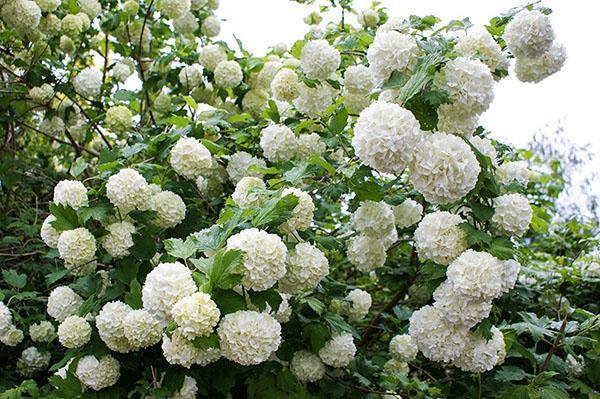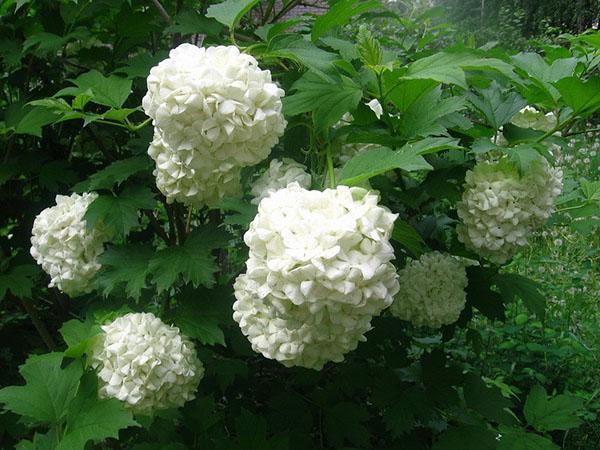Amazing snow globe - kalina buldenezh
 Kalina buldenezh is a tree widespread in the middle lane. High decorativeness and undemanding conditions made her an honorary guest in gardens and parks. This ancient variety was appreciated by gardeners even under Catherine II for its lush white inflorescences, similar to a snowball. The name of the variety - Boule de Neige - is translated from French and means "snow". For the first time, the description of viburnum buldenezh was made by the French breeder Lemoine, who bred this variety.
Kalina buldenezh is a tree widespread in the middle lane. High decorativeness and undemanding conditions made her an honorary guest in gardens and parks. This ancient variety was appreciated by gardeners even under Catherine II for its lush white inflorescences, similar to a snowball. The name of the variety - Boule de Neige - is translated from French and means "snow". For the first time, the description of viburnum buldenezh was made by the French breeder Lemoine, who bred this variety.
Description of the variety
Kalina buldenezh is a kind of viburnum ordinary and is a broadly spreading tree up to 4 meters high. With good care, this plant lives up to 50 years or more and every year pleases with long flowering. Buldenezh blooms with globular inflorescences in early summer. Long bloom, from 2 weeks to a month. Blooming flowers at first have a greenish tint, then become bright white, at the end of flowering turn pink.
A characteristic feature of the variety is the complete lack of smell in flowers. The plant is winter-hardy, but in severe winters it can partially freeze out. The root system is of the surface type.
Planting a seedling

- dig a hole at least 0.5x0.5 meters in size;
- drainage is laid on the bottom - fragments of brick, crushed stone, sand;
- prepare a nutrient mixture from compost, ash, complex fertilizer and garden land.
The seedling is immersed in a hole on a mound of nutrient mixture, the roots are spread, the root collar is buried a few centimeters and covered with the remaining soil. After planting, watered abundantly, and after settling, add more earth. From above, the landing site can be mulched so that the earth does not dry out quickly.
In group plantings, each seedling needs at least 4 square meters, since the tree is highly spreading.
Viburnum care
 Caring for Kalina Buldenezh consists in spring and autumn pruning and regular watering during dry periods. In the spring, the tree is examined and broken, dry and diseased branches are cut. In the fall, a formative pruning is carried out - excessively thickening and growing crowns are removed. With the help of formative pruning, a tree can be turned into a shrub - cut the trunk down to the level of the stump. In the spring, numerous side shoots will begin to grow from the root.
Caring for Kalina Buldenezh consists in spring and autumn pruning and regular watering during dry periods. In the spring, the tree is examined and broken, dry and diseased branches are cut. In the fall, a formative pruning is carried out - excessively thickening and growing crowns are removed. With the help of formative pruning, a tree can be turned into a shrub - cut the trunk down to the level of the stump. In the spring, numerous side shoots will begin to grow from the root.
All cuts after cutting should be disinfected with a solution of copper sulfate and covered with garden varnish.
In the conditions of the middle zone in October, abundant water-charging watering of the viburnum is carried out. Its purpose is to stimulate increased root growth and prevent them from freezing in winter. It is advisable to feed the tree before watering.
Fertilizers and feeding
For abundant and long-lasting flowering, Kalina Buldenezh needs to be fed regularly. In the first 2-3 years, the plant has enough nutrients laid in the planting hole. In the following years it is fed in the spring. nitrogen fertilizers or compost, in the fall - phosphorus and potash. Fertilizers can be scattered in the trunk circle, loosened with a rake and watered abundantly.In order for all the nutrients to get directly to the roots, another method is used:
- around the entire circumference of the trunk circle, holes are made in the ground with a depth of 20-30 cm using a garden drill, crowbar or wooden stake;
- a little fertilizer is poured into each;
- the entire rate calculated for a tree is divided by the number of holes;
- then the trunk circle is spilled with water.
Fertilizer rates indicated on the packaging should not be exceeded. The plant will not be able to assimilate them. This will lead to weed growth and soil contamination with nitrates and other chemicals.
Before flowering, viburnum can be sprayed with a complex fertilizer containing boron. This trace mineral stimulates profuse flowering.
Breeding options and methods
 Reproduction of viburnum buldenezh is possible only in a vegetative way, since it is sterile and does not give seeds. It is propagated in three ways - by layering, dividing the bush and cuttings.
Reproduction of viburnum buldenezh is possible only in a vegetative way, since it is sterile and does not give seeds. It is propagated in three ways - by layering, dividing the bush and cuttings.
In order to get a new plant by layering, you need to follow these steps:
- in the spring, next to the bush, dig longitudinal grooves;
- lay branches in them;
- press to the ground with wooden staples;
- cover this place with earth and keep it moist all summer.
By the fall, the cuttings have their own roots, and in the spring of next year, sprouts appear. A year later, when the cuttings get stronger and the root mass grows, the new plant can be separated from the mother plant by cutting the dug-in branch between them with a sharp shovel.
To propagate the viburnum in the second way - by dividing the bush - is much faster, but more painful for the whole plant, since the roots are more injured. This method is suitable only if it was formed like a bush and many branches come from the roots. To do this, the root system is partially dug up with a shovel and the bush is chopped up so that each part of it contains both roots and branches. Then all parts are deposited separately. After planting, the seedlings are watered.
The easiest way is to propagate the decorative viburnum buldenezh by cuttings. For cuttings, healthy branches removed during spring pruning will work. Each cutting should have several buds. They are buried in the ground obliquely so that half of the buds are in the ground. Their roots are subsequently formed. The cuttings are watered regularly. When a young bush with roots and branches is formed from the cutting, it can be planted in a permanent place or left in the same place.
The soil around the seedling should be kept moist and loose so that the roots have enough moisture and oxygen.
Viburnum pests and the fight against them
 The leaves of the viburnum buldenezh are strongly affected by three pests: the leaf beetle, scabbard and aphids.
The leaves of the viburnum buldenezh are strongly affected by three pests: the leaf beetle, scabbard and aphids.
The leaf beetle gnaws the leaves to the veins and is able to destroy the entire bush. To combat it, viburnum is sprayed with karbofos 2 times per season: in May to destroy the larvae, in August to get rid of adults.
To destroy scale insects and aphids, the plant is treated with "Aktara", "Fufanon", "Agravertin". With a small lesion, you can do with folk remedies: an infusion of garlic or ash with laundry soap.
Kalina buldenezh also suffers from powdery mildew... A set of measures will help against this fungal disease:
- spraying with a 0.5% solution of copper sulfate in early spring before the leaves bloom;
- reduction of watering, watering should be done only at the root;
- processing during the growing season with Bordeaux liquid;
- the destruction of weeds that carry powdery mildew, primarily wheatgrass.
Crowded plantings and thickened crown affect the incidence of viburnum. Any photo of a healthy Viburnum Buldenezh tree shows that it grows freely, the crown is thin enough, and the grass under the tree is mown.
 Following these simple guidelines will help you grow a healthy and beautiful tree. Decorative viburnum will live in your garden for a long time and every year it will delight you with an abundance of lush snow balls.
Following these simple guidelines will help you grow a healthy and beautiful tree. Decorative viburnum will live in your garden for a long time and every year it will delight you with an abundance of lush snow balls.
Kalina Buldenezh in landscape design, a photo of which only weakly reflects its exotic beauty, is used everywhere:


